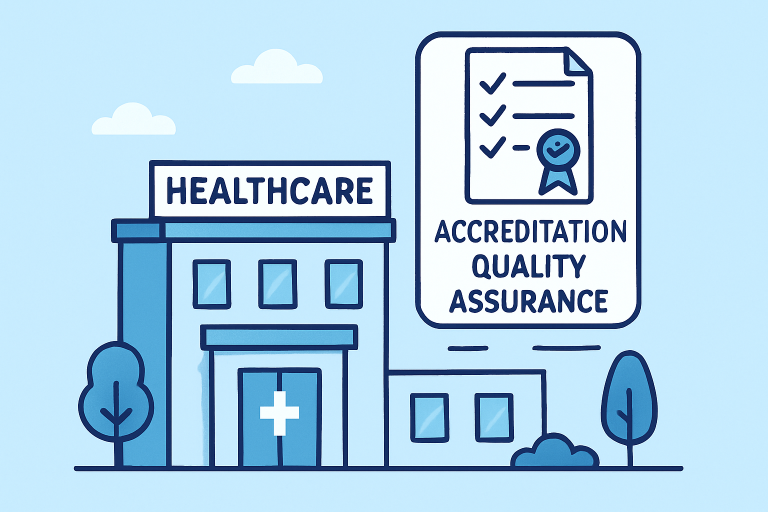Key takeaways:
- Accreditation validates a healthcare organization’s commitment to high-quality, safe, and ethical patient care.
- It strengthens patient trust and confidence in the facility’s standards and operations.
- Accreditation drives continuous improvement by encouraging adherence to best practices and industry benchmarks.
- It promotes accountability and teamwork across departments, aligning everyone toward shared goals.
- Accredited organizations gain a competitive edge through enhanced credibility and compliance readiness.
Introduction
In today’s healthcare landscape, accreditation stands as a crucial benchmark, distinguishing facilities that uphold rigorous safety, quality, and operational excellence standards. For organizations such as hospitals, clinics, and ambulatory surgery centers, earning accreditation is not just a regulatory milestone—it’s a public affirmation of their commitment to safe and effective patient care. The multi-faceted process requires strategic preparation, introspective evaluation, and ongoing improvement. Achieving surgery center accreditation represents more than meeting a checklist; it demonstrates a facility’s dedication to safeguarding patients and elevating outcomes.
Accreditation is propelled by independent, expert-driven assessments that evaluate whether a healthcare organization consistently meets established standards. This process is foundational to operational integrity, driving innovation and compliance, and ultimately fostering trust among patients, staff, and regulatory bodies.
Understanding Healthcare Accreditation
Healthcare accreditation is a formal, structured approach where a recognized, independent organization examines a facility to determine if it adheres to the industry’s best practices and quality benchmarks. These standards cover a wide range of criteria, including infection control, medication safety, clinical processes, and the organization’s capacity for continuous improvement. Accreditation is voluntary for many healthcare settings, but its benefits—enhanced patient care, reduced liability, and increased competitiveness—make it virtually indispensable for reputable providers.
The desired outcome of accreditation is twofold: verification of compliance with leading practice guidelines and identifying opportunities for long-term improvement. The process motivates healthcare facilities to exceed minimum requirements so that they can deliver consistent, high-quality care and improve patient outcomes continually.
Key Components of the Accreditation Process
- Self-Assessment: Before external evaluation, facilities conduct a detailed internal review to pinpoint gaps in compliance or quality. This introspection is the groundwork for developing action plans and setting improvement goals.
- On-Site Survey: Experienced surveyors, typically from clinical and administrative backgrounds, visit the facility to observe operations, conduct staff interviews, and review policies. This in-person assessment ensures that documentation aligns with real-world practices.
- Report and Decision: Following the survey, the accrediting organization delivers a comprehensive report detailing strengths and areas requiring attention. Facilities are then granted accreditation status—or are instructed to address deficiencies before it can be awarded.
- Continuous Improvement: Accreditation is not a one-time achievement. Accredited healthcare organizations engage in continuous quality improvement, routinely monitoring compliance and seeking ways to raise their standard of care.

Benefits of Accreditation
Accreditation yields significant, organization-wide benefits:
- Enhanced Patient Safety: Structured protocols reduce variability and errors, contributing to improved health outcomes.
- Improved Service Quality: Rigorous evaluation and performance feedback drive ongoing improvement in patient care.
- Increased Public Trust: Accredited facilities demonstrate their commitment to high standards, cultivating confidence among patients and the wider community.
- Professional Development: Staff benefit from a culture of lifelong learning and regular training, sharpening their skills and updating their knowledge base.
- Regulatory Compliance: Many accredited organizations are better positioned to meet federal and state regulatory mandates, reducing risks and avoiding legal or financial penalties.
Challenges in Achieving Accreditation
Despite its numerous advantages, pursuing accreditation is not without obstacles:
- Resource Allocation: The process is resource-intensive, often demanding significant investments of staff time, finances, and technological support.
- Staff Engagement: Accreditation requires a facility-wide culture shift. Ensuring all team members—from leadership to front-line staff—are engaged and motivated is an ongoing challenge.
- Maintaining Compliance: Standards and regulations evolve frequently. Remaining compliant requires an ongoing commitment to education, process improvement, and adaptability.
Recent Developments in Healthcare Accreditation
In June 2025, The Joint Commission revolutionized the field by launching “Accreditation 360: The New Standard,” a modernized, outcome-driven accreditation platform. This comprehensive program retired over 700 redundant or outdated standards, replacing them with clear, focused requirements designed to minimize administrative burdens while keeping patient outcomes central. Facilities can expect a more supportive, real-time engagement from surveyors and accrediting bodies—paving the way for meaningful, sustainable improvements in quality and safety.
Steps to Prepare for Accreditation
- Understand the Standards: Begin by familiarizing yourself with the specific requirements of the targeted accrediting body, whether national or specialty-based.
- Conduct a Gap Analysis: Methodically compare current practices with accreditation standards to identify any existing shortcomings.
- Develop an Action Plan: Outline detailed steps to address deficiencies, assign responsibilities, and establish deadlines.
- Implement Changes: Mobilize staff, update policies, and modify workflows as outlined in the action plan.
- Monitor Progress: Use regular checkpoints to track improvements, address unforeseen challenges, and adjust strategies as required.
- Engage in Mock Surveys: Rehearse for the official accreditation survey by conducting internal audits and simulation exercises, helping staff gain confidence and discover areas for refinement.
Final Thoughts
Accreditation is a dynamic journey toward excellence, marked by rigorous evaluation, dedication, and the unwavering goal of advancing patient care. By understanding its complexities and opportunities, healthcare organizations can elevate their services, strengthen public trust, and ensure that they not only meet—but set—the standards that define outstanding care.









